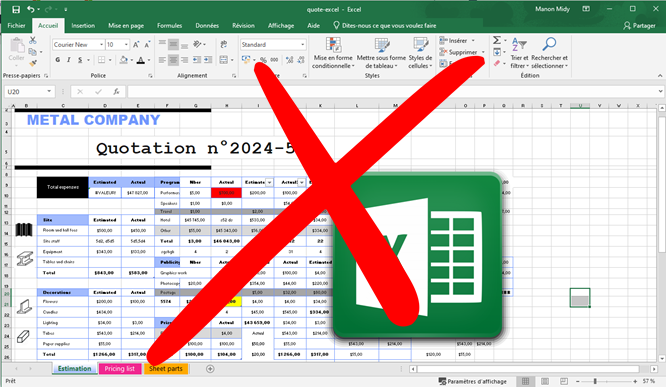As a player in the sheet metal cutting and welding industry, you know the importance of accurate calculations when drawing up a quotation. Although Microsoft Excel is widely used for creating tables, it can prove to be the wrong tool for creating quotations in our specific sector. Here’s the 5 reasons.

Calculation complexity
Sheet metal cutting often involves complex geometric shapes and special estimating calculations. Excel can quickly show its limitations when it comes to managing advanced calculations related to the various stages of sheet metal cutting, shape geometry, material thickness, etc. The calculation formulas used to arrive at a result are often tedious and error-prone.
Lack of precision and wasted time
Estimates in the sheet metal cutting industry need to be precise and indicative of what’s going to happen next on the shop floor. There are too many parameters to take into account to arrive at a reliable estimate in Excel. And you’ll need to update the calculations for each formula as soon as any element changes. Here too, the risk of errors in the calculations is high, which can lead to incorrect estimates and wasted time for re-evaluation.
Difficulty of adaptation to change
Customer requirements in the mechanical welding industry can change rapidly. Excel does not facilitate smooth management of design changes, which can lead to delays and unforeseen costs.
No CAM integration
If we want to move towards Industry 4.0 and really increase productivity, collaboration between the company’s various software packages is essential. Excel will have difficulty integrating properly with tools specific to sheet metal design and cutting. For example, how do you integrate Excel with CAD-CAM nesting software? Or how to retrieve CAD-designed assemblies in Excel?
Lack of traceability and global vision
If you use Excel to manage your quotations, it’s likely that the files are stored on individual computers, potentially scattered across several workstations. Two major risks here: non-uniformity of quotations sent and lack of traceability. All this slows down collaboration and doesn’t give you overall visibility of your sales activity.
In conclusion, although Excel is a versatile tool, it doesn’t easily meet the specific needs and challenges of the sheet metal cutting and welding industry. Using it can lead to errors and inefficiencies.
So how can you quickly produce reliable cutting quotations?
Implementing a quotation management solution designed for CAM cutting
To stay competitive, many manufacturers have left Excel behind and opted for a quotation software solution specialized for the cutting sector.
Designed for sales or customer management staff, a quotation software for sheet metal doesn’t require advanced expertise in design or nesting. It’s an automated system that will generate the best possible nesting of parts, estimate manufacturing costs, analyze the time required, and automatically generate a quotation. Estimates will be accurate and faithful to reality, whatever the cutting method (punching, cutting, bending, welding).
So, by automating the quotation process, sales managers can respond faster to requests for quotes, reduce calculation errors and improve the accuracy of estimates.
